| Overview | |
|---|---|
| Other name(s) | Brown Queen Tunnel |
| Location | Cornwall, England |
| Coordinates | North Portal: 50°26′06″N4°40′51″W / 50.434958°N 4.680927°W South Portal: 50°26′03″N4°40′51″W / 50.43422°N 4.680884°W |
| Status | Active |
| Operation | |
| Opened | 4 May 1859 |
| Operator | Cornish Main Line |
| Character | Through-rail passenger and freight. |
| Technical | |
| No. of tracks | 2 single track |
| Track gauge | 1,435 mm (4 ft 8 1⁄2 in) (standard gauge) |
Brownqueen Tunnel, also called Brown Queen Tunnel, is a railway tunnel on the Cornish Main Line between Lostwithiel and Bodmin Parkway stations in Cornwall, England.
The tunnel is aligned approximately north-south and is on a left-hand curve and a falling gradient when travelling in the down direction. The tunnel itself is 264 feet (80 m) long [1] although one source gives the length as 237 feet (72 m) [2] and the up portal is 278 miles 16 chains from London according to the mileposts. Situated just above the River Fowey, Brownqueen Tunnel is in the same area as "Brownqueen Wood", a small forested area of about 6.08 hectares (15.0 acres). [3]
South of the tunnel, trains pass Restormel Castle, one of the four chief Norman castles of Cornwall. [4] To the north of the tunnel are the historic Glynn House and Bodmin Parkway station. [5] [6]
The tunnel opened on 4 May 1859, when the Cornwall Railway opened between Plymouth and Truro, and is still in use today. [5]
This is one of five tunnels on the Cornwall Railway, all of which are lined with masonry and topped by brickwork at the crown of the arch. [5] This tunnel passes through 216 feet (66 m) of hard greenstone which the builders were able to drill and blast through using nine tons of powder (because dynamite had not yet been invented). [5]
On 7 November 1903, the architect Silvanus Trevail committed suicide in the toilet of a train in the tunnel. Trevail caught the 11.40 up train from Truro, having purchased a third class ticket, a peculiar event as he typically travelled first class. At Par railway station he was witnessed leaving his seat and going to the toilet. As the train entered the Brownqueen tunnel, Trevail shot himself; when the train stopped at Bodmin Road, a porter was called, and Trevail’s body was found lying across the toilet. [7] [8]
The name "Brownqueen", which applies to both the tunnel and the forest around it, is a modern corruption of the old Cornish term "Brow Gwyn", meaning "white mound". [9] It is also spelled "brownquin", and can be translated as "white hill". [10]

Bodmin is a civil parish and historic town in Cornwall, England, United Kingdom. It is situated south-west of Bodmin Moor.

St Austell is a town in Cornwall, England, UK, 10 miles (16 km) south of Bodmin and 30 miles (48 km) west of the border with Devon.

Carbis Bay is a seaside resort and village in Cornwall, UK. It lies one mile southeast of St Ives, on the western coast of St Ives Bay, on the Atlantic coast. The South West Coast Path passes above the beach.

St Columb Major is a town and civil parish in Cornwall, England, United Kingdom. Often referred to locally as St Columb, it is approximately seven miles (11 km) southwest of Wadebridge and six miles (10 km) east of Newquay The designation Major distinguishes it from the nearby settlement and parish of St Columb Minor on the coast. An electoral ward simply named St Columb exists with a population at the 2011 census of 5,050. The town is named after the 6th-century AD Saint Columba of Cornwall, also known as Columb.
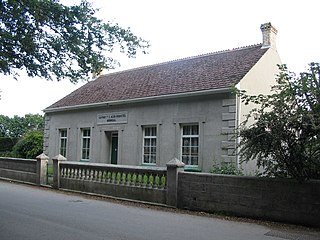
Luxulyan, also spelt Luxullian or Luxulian, is a village and civil parish in mid Cornwall, England, United Kingdom. The village lies four miles (6.5 km) northeast of St Austell and six miles (10 km) south of Bodmin. The population of the parish was 1,371 in the 2001 census. This had risen to 1,381 at the 2011 census.

Bodmin Parkway railway station is on the Cornish Main Line that serves the nearby town of Bodmin and other parts of mid-Cornwall, England. It is situated 3 miles (4.8 km) south-east of the town of Bodmin in the civil parish of St Winnow, 274 miles 3 chains (441.0 km) from London Paddington measured via Box and Plymouth Millbay.
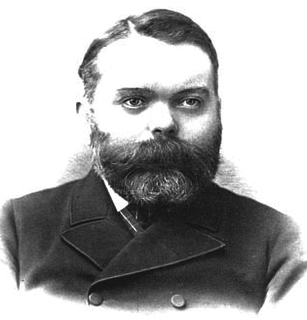
Silvanus Trevail was a British architect, and the most prominent Cornish architect of the 19th century.

Truro railway station serves the city of Truro, Cornwall, England. The station is 301 miles (484 km) from London Paddington via Bristol Temple Meads. It is situated on the Cornish Main Line and is the junction for the Maritime Line to Falmouth Docks.
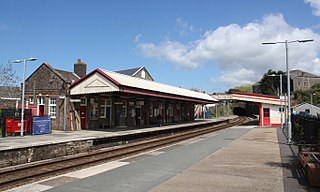
Redruth station serves the town of Redruth, Cornwall, United Kingdom, and is situated on the Cornish Main Line between Truro and Camborne. The station is 310 miles (500 km) from London Paddington via Bristol Temple Meads.

The Cornwall Railway was a 7 ft 1⁄4 in broad gauge railway from Plymouth in Devon to Falmouth in Cornwall, England, built in the second half of the nineteenth century. It was constantly beset with shortage of capital for the construction, and was eventually forced to sell its line to the dominant Great Western Railway.

Falmouth Docks railway station is situated in Falmouth, Cornwall, England. It was opened in 1863 as the terminus of the Maritime Line from Truro, although since 1970 Falmouth Town has been the principal station for the town. Falmouth Docks is 312 miles 46 chains (503.04 km) measured from London Paddington.

Lelant is a village in west Cornwall, England, UK. It is on the west side of the Hayle Estuary, about 2 1⁄2 miles (4.0 km) southeast of St Ives and one mile (1.6 km) west of Hayle. The village is part of St Ives civil parish, the Lelant and Carbis Bay ward on Cornwall Council, and also the St Ives Parliamentary constituency. The birth, marriage, and death registration district is Penzance. Its population at the 2011 census was 3,892 The South West Coast Path, which follows the coast of south west England from Somerset to Dorset passes through Lelant, along the estuary and above Porth Kidney Sands.
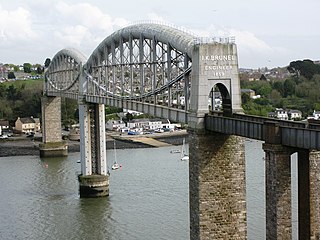
The Cornish Main Line is a railway line in Cornwall in the United Kingdom. It runs from Penzance to Plymouth, crossing from Cornwall into Devon over the famous Royal Albert Bridge at Saltash.
There are seventeen disused railway stations on the Cornish Main Line between Plymouth in Devon and Penzance in Cornwall, England. The remains of nine of these can be seen from passing trains. While a number of these were closed following the so-called "Beeching Axe" in the 1960s, many of them had been closed much earlier, the traffic for which they had been built failing to materialise.
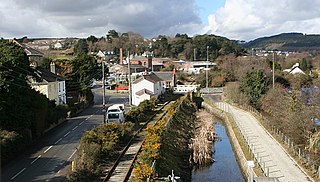
The evolution of transport in Cornwall has been shaped by the county's strong maritime, mining and industrial traditions and much of the transport infrastructure reflects this heritage.

Temple is a small village in the parish of Blisland on Bodmin Moor in Cornwall, England, UK. The village is bypassed by the A30 road.

Trethurgy is a village in the parish of Treverbyn, Cornwall, England, United Kingdom. It is about two miles northeast of St Austell. Carne Farm, Trethurgy is the birthplace of Silvanus Trevail, a president of the Society of Architects and the architect of many well known Cornish hotels such as the Headland Hotel, Newquay and the Carbis Bay Hotel, Carbis Bay.
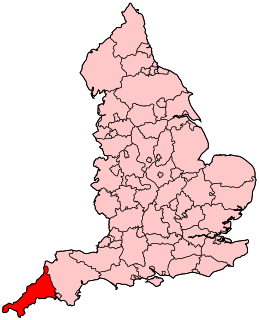
The following outline is provided as an overview of and topical guide to Cornwall: Cornwall – ceremonial county and unitary authority area of England within the United Kingdom. Cornwall is a peninsula bordered to the north and west by the Celtic Sea, to the south by the English Channel, and to the east by the county of Devon, over the River Tamar. Cornwall is also a royal duchy of the United Kingdom. It has an estimated population of half a million and it has its own distinctive history and culture.
Presented below is an alphabetical index of articles related to Cornwall:

The Great Western Hotel is the oldest purpose built hotel in Newquay, Cornwall. The hotel was originally designed by the Cornish architect Silvanus Trevail and first opened in April 1879. The hotel is built in a prominent position overlooking Great Western Beach.